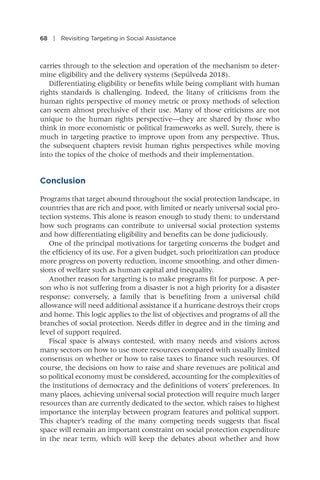68 | Revisiting Targeting in Social Assistance
carries through to the selection and operation of the mechanism to determine eligibility and the delivery systems (Sepúlveda 2018). Differentiating eligibility or benefits while being compliant with human rights standards is challenging. Indeed, the litany of criticisms from the human rights perspective of money metric or proxy methods of selection can seem almost preclusive of their use. Many of those criticisms are not unique to the human rights perspective—they are shared by those who think in more economistic or political frameworks as well. Surely, there is much in targeting practice to improve upon from any perspective. Thus, the subsequent chapters revisit human rights perspectives while moving into the topics of the choice of methods and their implementation.
Conclusion Programs that target abound throughout the social protection landscape, in countries that are rich and poor, with limited or nearly universal social protection systems. This alone is reason enough to study them: to understand how such programs can contribute to universal social protection systems and how differentiating eligibility and benefits can be done judiciously. One of the principal motivations for targeting concerns the budget and the efficiency of its use. For a given budget, such prioritization can produce more progress on poverty reduction, income smoothing, and other dimensions of welfare such as human capital and inequality. Another reason for targeting is to make programs fit for purpose. A person who is not suffering from a disaster is not a high priority for a disaster response; conversely, a family that is benefiting from a universal child allowance will need additional assistance if a hurricane destroys their crops and home. This logic applies to the list of objectives and programs of all the branches of social protection. Needs differ in degree and in the timing and level of support required. Fiscal space is always contested, with many needs and visions across many sectors on how to use more resources compared with usually limited consensus on whether or how to raise taxes to finance such resources. Of course, the decisions on how to raise and share revenues are political and so political economy must be considered, accounting for the complexities of the institutions of democracy and the definitions of voters’ preferences. In many places, achieving universal social protection will require much larger resources than are currently dedicated to the sector, which raises to highest importance the interplay between program features and political support. This chapter’s reading of the many competing needs suggests that fiscal space will remain an important constraint on social protection expenditure in the near term, which will keep the debates about whether and how


